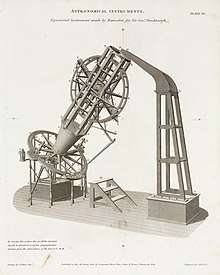Shuckburgh telescope
The Shuckburgh telescope or Shuckburgh equatorial refracting telescope was a 4.1 inches (10.4 cm) diameter aperture telescope on an equatorial mount completed in 1791 for Sir George Shuckburgh (1751–1804) in Warwickshire, England, and built by British instrument maker Jesse Ramsden (1735–1800).[1][2][3][4][5] It was transferred to the Royal Observatory, Greenwich in 1811 and the London Science Museum in 1929.[2] Even though it has sometimes not been regarded as particularly successful, its design was influential.[3] It was one of the larger achromatic doublet telescopes at the time, and one of the largest to have an equatorial mount.[2] It was also known as the eastern equatorial for its location.[6]
 | |
| Alternative names | Shuckburgh equatorial refracting telescope |
|---|---|
| Location(s) | United Kingdom |
| Telescope style | optical telescope |
| Diameter | 4.1 in (0.10 m) |
| Mounting | Equatorial mount |
It was pictured in the Rees Cyclopedia of the early 1800s.[7] It was early pictured in Philosophical Transactions, published in 1793.[8]
At the Royal Observatory in Greenwich, it was for a time installed in the North Dome, although this had a Sky view partially obscured by the Octagon room.[9][10] It was earlier installed as an alt-az mount in the South dome at Greenwich, which in 1838 is where the then-new 6.7 inch aperture Sheepshanks refractor was installed.[11]
The telescope tube is 5 feet four inches long (about 1.6 meters).[9] The focal length was the same for this telescope, with object glass being doublet of 4.1 inch (~10.4 cm) aperture.[12]
Shuckburgh placed an order with Ramsden for the telescope in 1781, and it was delivered for his observatory ten years later.[13]He also ordered a clock from John Arnold & Son to use with the telescope.[13] The telescope was installed at Shuckburgh Hall, in Warwickshire, United Kingdom.[13]
Observations
The Shuckburgh/ Eastern telescope was used for the 1832 transit of Mercury with equipped with a micrometer by Dollond.[14] By observing the transit in combination with timing it and taking measures, a diameter for the planet was taken.[14] They also reported the peculiar effects that they compared to pressing a coin into the Sun.[14] The observer remarked:
I afterwards observed, that immediately around the planet there was a dusky tinge, making it appear as if, in a small degree sunk below the sun's surface;"
— Royal Astronomical Society, Vol II, No. 13[14]
The Shuckburgh and the western equatorial at Greenwich are recorded as having been used for observations of the 1835 apparition of Halley's Comet.[15]
The Shuckburgh, also called the "Eastern Equatorial" at the time Halley's comet was sometimes used with a micrometer microscope.[6] For the observations of Halley's 1835, the Transit and Arnold 1 and 2 clocks were used.[6] Observations were recorded in August, September, and October, but it could not view the comet after October 19th, because its view was blocked by another part of the observatory building.[6]
The Shuckburgh is also reported to have been used for observing the occultation of stars by the Moon and observing the moons of Jupiter.[16]
See also
- Aerial telescope
- Edward Troughton
- Peter Dollond
- Great refractors
- List of largest optical telescopes in the 18th century
- Greenwich 28 inch refractor (Another RGO telescope)
- List of largest optical telescopes in the British Isles
- Sheepshanks equatorial (6.7 inch refractor also at Greenwich)
References
- Winterhalter, Albert Gustavus (1889), The International Astrophotographic Congress and a Visit to Certain European Observatories and Other Institutions: Report to the Superintendent [of the U.S. Naval Observatory]. Washington observations for 1885. Appendix I, U.S. Government Printing Office, p. 151.
- McConnell, Anita (2007), "Sir George Shuckburgh's Observatory", Jesse Ramsden (1735-1800): London's Leading Scientific Instrument Maker, Science, technology, and culture, 1700-1945, Ashgate Publishing, Ltd., pp. 135–137, ISBN 9780754661368.
- Andrews, A. D. (1996), "Cyclopaedia of Telescope Makers Part 5 (Sae-Sim)", Irish Astronomical Journal, 23 (1): 57–117, Bibcode:1996IrAJ...23...57A. The Shuckburgh telescope is described on p. 99.
- Hingley, Peter D. (2013). "The Shuckburghs of Shuckburgh, Isaac Fletcher, and the History of the English Mounting". The Antiquarian Astronomer. Society for the History of Astronomy. 7: 17–40. Bibcode:2013AntAs...7...17H. Retrieved 17 February 2016.
- Anita, McConnell (2013). "Jesse Ramsden: the Craftsman who Believed that Big was Beautiful". The Antiquarian Astronomer. Society for the History of Astronomy. 7: 41–53. Bibcode:2013AntAs...7...41M. Retrieved 21 February 2016.
- Astronomical Observations. By J. Pond, Published by the President and Council of the Royal Society. 1811-35. 1835.
- "Image of shuckburgh telescope, 1820. by Science & Society Picture Library". www.scienceandsociety.co.uk. Retrieved 2018-01-24.
- "The Royal Observatory Greenwich - where east meets west: Telescope: The Shuckburgh Equatorial (1791)". www.royalobservatorygreenwich.org. Retrieved 2018-01-24.
- Observations Made at the Royal Observatory, Greenwich in the Year ... in Astronomy, Magnetism and Meteorology. H.M. Stationery Office. 1904.
- "1896GOAMM..55....1C Page I". adsabs.harvard.edu. p. XVII. Retrieved 2019-10-31.
- Forbes, Eric Gray; Meadows, Arthur Jack; Howse, Derek (1975). Greenwich Observatory ... the Story of Britain's Oldest Scientific Institution, the Royal Observatory at Greenwich and Herstmonceux, 1675-1975. Taylor & Francis Group. ISBN 9780850660951.
- "1896GOAMM..55....1C Page I". adsabs.harvard.edu. p. XVII. Retrieved 2019-10-31.
- McConnell, Anita (2007). Jesse Ramsden (1735-1800): London's Leading Scientific Instrument Maker. Ashgate Publishing, Ltd. ISBN 9780754661368.
- Monthly Notices of the Royal Astronomical Society. Priestley and Weale. 1831.
Shuckburgh telescope eastern equatorial.
- "The Royal Observatory Greenwich - where east meets west: Telescope: The Western Equatorial (c.1824)". www.royalobservatorygreenwich.org. Retrieved 2019-10-28.
- Observatory, Royal Greenwich (1889). Introduction to Greenwich Astronomical Observations. H.M. Stationery Office.
External links
- Image of Shuckburgh's telescope at London Science Museum and print of the telescope, general view, Ingenious
- Illustration of the Shuckburgh telescope circa 1816 at the Royal Observatory, from Andrews, A. D. (1996), "Cyclopaedia of Telescope Makers Part 6 (Sin-Syk)", Irish Astronomical Journal, 23 (2): 215–242, Bibcode:1996IrAJ...23..215A